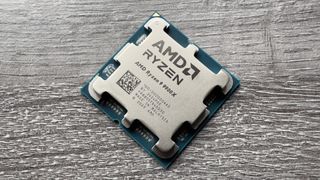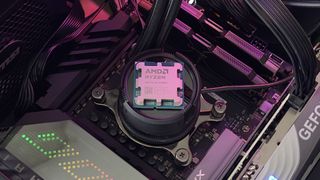With the retail launch of its Ryzen 9000-series of processors, AMD chose to stagger the releases, with the more affordable Ryzen 5 9600X and Ryzen 7 9700X hitting shelves last week. Now it’s the turn of the top-end chips and first up is the $499 Ryzen 9 9900X.
Let me begin by confessing my bias for AMD’s 12-core processors, as I really rate the Ryzen 9 7900X and 7900. The latter has been a solid workhorse of a chip, powering my primary AM5 test PC, running games and content creation apps with ease. Sure, the full-fat 16-core models top the charts when it comes to multithreaded performance and you can’t beat the X3D chips, with their extra L3 cache, for gaming but the Ryzen 9 7900 really is a fantastic all-round CPU.
I was keen on seeing what the Zen 5 update of one of my favourite chips was going to be like but after reviewing the 9600X and 9700X, I realised that I would need to temper my expectations somewhat. What I didn’t realise at the time was just how much I’d need to lower my hopes.
The Ryzen 9 9900X comprises three chiplets underneath the heatspreader—two CCDs (Core Complex Dies), each with six cores and 12 threads, and a single IOD (Input/Output Die). That’s exactly the same as the previous Ryzen 9 7900X model but there are some further revisions, other than the obvious AMD Zen 5 architecture advances.
Ryzen 9 9900X specs

Cores: 12
Threads: 24
Base clock: 4.5 GHz
Boost clock: 5.6 GHz
L3 Cache: 64 MB
L2 Cache: 12 MB
Unlocked: Yes
Max PCIe lanes: 24
Graphics: Radeon Graphics
Memory support (up to): DDR5-5800
Processor Base Power (W): 120
Maximum Package Power (W): 162
Recommended customer price: $499/£459.99
Where the 7900X has a base clock of 4.7 GHz and a TDP of 170 W, the new 9900X has a base clock of 4.4 GHz and a much lower TDP, just 120 W. The boost clocks are the same for both chips (5.6 GHz) so the new model has a smaller power budget with which to maintain boost clocks when under heavy load.
Upon installing the chip, the first thing I checked out was the idle behaviour, as this was something that I’d noticed with the 9600X and 9700X as being unusual, compared to AMD’s figures. Once again, my configuration of Windows and an Asus ROG Crosshair X670E Hero motherboard, using an AMD-supplied 2201 BIOS, resulted in an elevated idle power consumption, typically around the 40 W mark.
For cooling, I used an Asus ROG Strix LC III 360 mm AIO liquid cooler, and it had no problem dealing with this—in fact, it idled a good 10 °C cooler than the 9600X, so the high-ish idle power consumption wasn’t a problem. I suspect that this will all be resolved in time, although AMD did suggest that one should be using the Balanced power profile in Windows. I tried all of them and it didn’t make a jot of difference.
Anyway, you’re here for the benchmarks, so let’s start with the good news. The Ryzen 9 9900X is great in tests that mimic the CPU workloads experienced in content creation and other professional applications, such as rendering, file compression and decompression, and video editing.
If your PC is used primarily for productivity tasks, then the fast performance and relatively low power consumption of the Ryzen 9 9900X clearly make it an ideal choice for anyone considering Zen 5 for a prosumer workstation. Well, there is a big Eco-mode caveat to all that, however, which I’ll come to shortly.
On the other hand, if you do more gaming on a PC than professional work, then the 9900X isn’t ideal at all. Yes, it does outperform the 7900X in all our gaming tests, but the margin is very small—the exception being Metro Exodus Enhanced, which is very twitchy about what platform it’s being run on.
Compared to my much-beloved 65 W Ryzen 9 7900, the Ryzen 9 9900X is quite underwhelming, as it’s really not that much faster at all. Only the Factorio benchmark showed an appreciable difference in processing.
PCG test rig
Motherboard: Asus ROG Crosshair X670 Hero
Cooler: Asus ROG Strix LC III 360
RAM: 32 GB Lexar Thor OC DDR5-6000
Storage: 2 TB Adata XPG Gammix S70
PSU: MSI MAG AB50GL 850 W
OS: Windows 11 23H2
Chassis: Open platform w/ 3x 140 mm fans
Monitor: Acer XB280HK
The somewhat muted gaming performance isn’t such bad news, though, as the raw figures themselves are fine—it’s certainly not slow in any of our gaming tests.
No, the real bad news is the Eco mode. The one thing we in the PC Gamer hardware team all liked about the Ryzen 7900X and its bigger sibling, the Ryzen 9 7950X, was that you could enable Eco mode in the BIOS, slice a healthy chunk off the TDP, but still have a great CPU. Here, setting the 9900X to 65 W resulted in a not-great CPU.
In this mode, the Ryzen 9 9900X performed slower than the 7900 in games and in applications that loaded up all the chip’s cores, such as Blender or Handbrake. That’s despite all of the Zen 5 architecture changes.

On face value, one would think that it can’t be the power limits, as the Ryzen 9 7900X and 7900 are 170 W and 65 W chips, respectively, so there should be no obvious reason as to why the 9900X should struggle with going from 120 to 65 W.
However, the 9900X does have quite high clocks and I suspect that all of the changes within the Zen 5 CCDs mean that they need more power than their predecessors when it comes to maintaining performance in heavy workloads.
Buy if…
✅ You want a fast chip for content creation: In Blender and Handbrake, the Ryzen 9 9900X is faster than the Core i7 14700K.
✅ You want a cool office: Consuming no more than 162 W at full load is a seriously impressive feat for a 24-thread CPU.
Don’t buy if…
❌ You want value for money: The Ryzen 9 9900X isn’t massively better than the Ryzen 9 7900X but it costs 40% more than the last-gen chip.
AMD could perhaps remedy this by offering an additional Eco mode, as it does with its 170 W chips. With those, one can choose 105 or 65 W, but since the Ryzen 9 9900X is a 120 W chip, you only get a 65 W Eco option. With an 80 or 90 W option, things might be fine, but it does make me a little concerned about what the inevitable non-X version of the 9900 will be like.
If you’re an Intel user, seeing a fast multithreaded chip use no more than 162 W in Cinebench—over 100 W less power than the Core i7 14700K—might just tempt you to switch platform and pick up the Ryzen 9 9900X. But here comes a caveat of more tangible import than the Eco mode issue, and it comes in the shape of the Ryzen 9 7900X. The new Zen 5 chip has an MSRP of $499, a pleasing $50 lower than the 7900X’s launch price, but you can pick up the latter for $359 on Amazon right now.
That makes the 9900X roughly 40% more expensive than the 7900X but it’s certainly not 40% faster. The new chips will certainly drop in price over time, and given the rather mixed reception of the Ryzen 9000-series, it could happen sooner than you think. But as things stand at the moment, I can’t recommend the Ryzen 9 9900X—it’s not a bad CPU by any means, just a disappointing one for the money.

